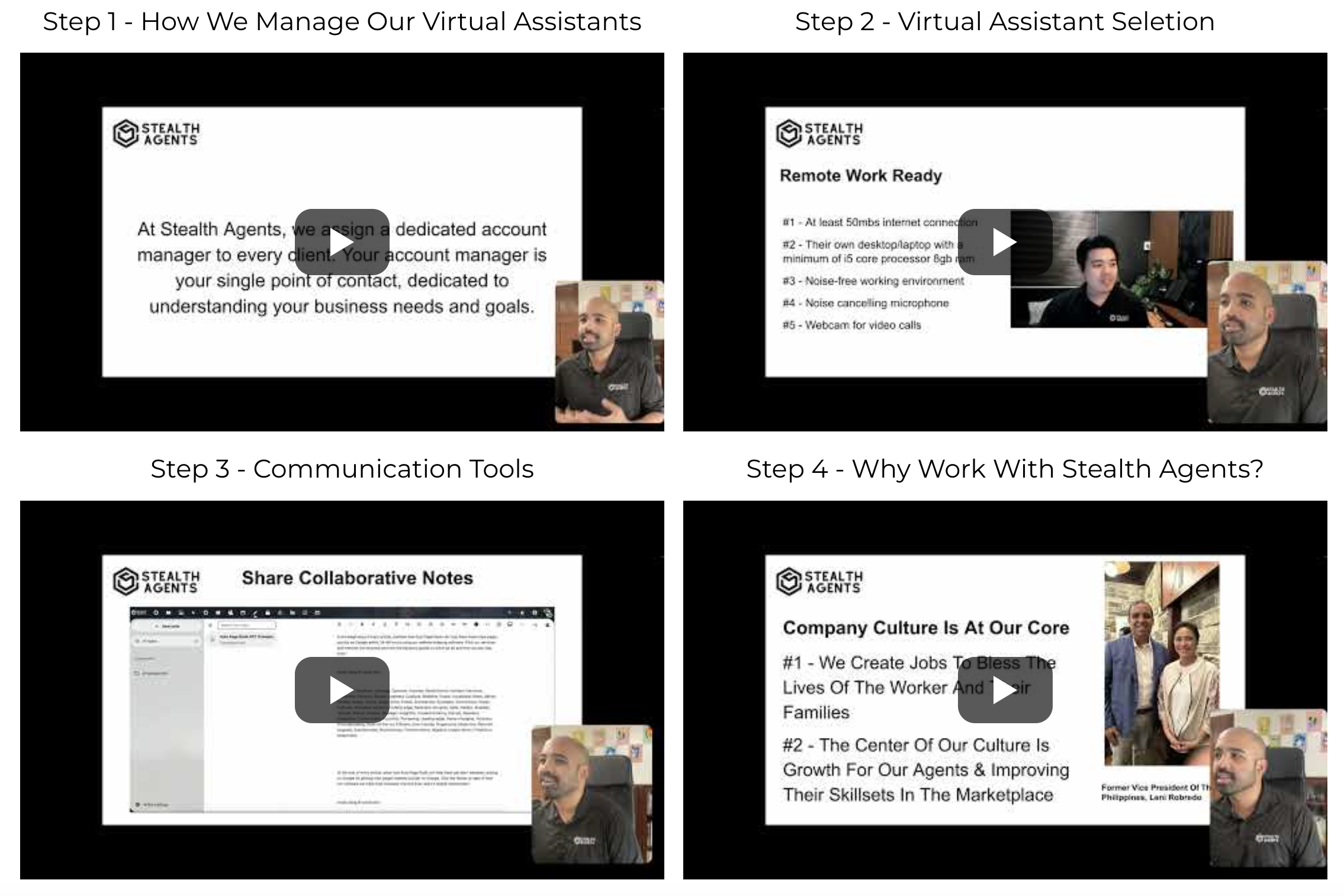Navigating the landscape of team collaboration tools can be daunting, especially when comparing robust platforms like Slack and Click Up.
Slack, primarily known for its real-time communication capabilities, excels in fostering seamless team interaction and maintaining an open channel for discussions.
On the other hand, Click Up is designed with comprehensive project management features, enabling teams to streamline workflows and track project progress efficiently.
Understanding these differences is crucial for businesses looking to enhance productivity, whether they need dynamic communication or structured task management.
Virtual assistants play a pivotal role in optimizing the use of these tools, offering virtual assistant services that can streamline operations and ensure seamless integration.
Moreover, understanding virtual assistant pricing helps businesses make informed decisions tailored to their specific needs.
This insightful resource has been meticulously created and curated by Stealth Agents to guide you through these considerations.
What is Slack?
Slack is a powerful communication platform designed to enhance team collaboration by offering a suite of tools that facilitate real-time messaging, file sharing, and integration with various apps.
It provides a centralized space where team members can create channels for specific projects or topics, ensuring organized and focused discussions.
With its user-friendly interface, Slack makes it easy to search past conversations and retrieve important information quickly.
It supports a wide range of integrations, allowing users to connect with tools they already use, thereby streamlining workflows and improving productivity.
By offering features for both small teams and large enterprises, Slack has positioned itself as a versatile solution for business communication.
Key Features:
- Real-time messaging for instant communication across teams.
- Channels for organizing discussions by project, topic, or department.
- Integration capabilities with over 2,000 apps to streamline workflows.
- File sharing for easy collaboration on documents and media.
- Search functionality to quickly find past conversations and files.
Pros:
- Slack’s intuitive interface makes it accessible for new users, providing a seamless onboarding experience and reducing the learning curve.
- The platform’s robust integration options mean teams can customize their Slack experience to fit their specific needs, enhancing productivity by consolidating tools.
- With its real-time notifications and updates, Slack keeps everyone in the loop, fostering a responsive and agile work environment.
- Slack’s free tier offers substantial functionality, making it an attractive option for startups and small teams looking to manage their budgets efficiently.
- The ability to create private channels and direct messages ensures sensitive information can be shared securely, adding a layer of privacy to team communications.
Cons:
- Some users may find the constant stream of notifications overwhelming, leading to potential distractions and interruptions in workflow.
- While integration is a strength, managing numerous app connections can become complex, requiring careful organization to avoid chaos.
- The search function, though powerful, can sometimes yield too many results, making it difficult to locate specific information quickly.
- For larger teams, the free version’s limitations on message history can be restrictive, necessitating an upgrade to a paid plan for full access.
- As Slack becomes central to team communication, over-reliance on the platform might lead to reduced face-to-face interactions and potential communication gaps.
What is Click Up?
ClickUp is a versatile project management tool designed to streamline workflows and enhance team productivity.
It offers a centralized platform where teams can collaborate, manage tasks, and track project progress efficiently.
With its customizable interface, ClickUp adapts to the unique needs of any organization, making it a popular choice across various industries.
The tool integrates seamlessly with other applications, allowing users to synchronize data and maintain consistent communication across platforms.
Its robust feature set empowers teams to manage everything from simple to complex projects with ease, ensuring deadlines are met and goals are achieved.
Key Features:
-
Task Management: ClickUp allows users to create, assign, and prioritize tasks with ease. It provides a variety of views such as lists, boards, and calendars to accommodate different work styles.
-
Customization: Users can tailor the platform with custom statuses, fields, and tags to fit their specific needs. This flexibility helps teams create a workflow that mirrors their processes.
-
Time Tracking: Built-in time tracking capabilities enable users to monitor how much time is spent on tasks. This feature helps optimize efficiency and manage resources effectively.
-
Collaboration Tools: ClickUp offers a range of collaboration features, including document sharing, live chat, and comment threads. These tools facilitate seamless communication and ensure everyone is on the same page.
-
Integrations: The platform supports integration with numerous third-party applications like Slack, Google Workspace, and Zoom. This allows teams to maintain a cohesive digital ecosystem without switching between multiple tools.
Pros:
-
Comprehensive Features: ClickUp offers a wide array of tools beyond basic task management, such as goal setting and time tracking. This makes it suitable for both simple and complex projects.
-
User-Friendly Interface: Despite its powerful features, ClickUp maintains an intuitive and user-friendly interface. This ensures a smooth onboarding process for new users.
-
Cost-Effective Options: ClickUp provides a free plan with essential features and affordable pricing tiers for more advanced needs. This flexibility makes it accessible to businesses of all sizes.
-
Effective Collaboration: With its robust collaboration features, ClickUp enhances team communication and project visibility. This leads to improved productivity and project outcomes.
-
Continuous Improvement: ClickUp frequently updates its software, introducing new features and improvements. This commitment to growth ensures that users have access to the latest tools and capabilities.
Cons:
-
Learning Curve: Due to its extensive feature set, new users may experience a steep learning curve. This can require additional time and resources for training.
-
Complexity for Small Teams: For smaller teams with simpler needs, ClickUp’s comprehensive features might feel overwhelming. This could lead to underutilization of the tool.
-
Notification Overload: The platform’s frequent notifications can become overwhelming if not managed properly. Users may need to adjust settings to avoid distractions.
-
Occasional Lag: Some users report performance issues, such as slow loading times, especially with larger projects. This can hinder productivity during peak usage periods.
-
Customization Challenges: While customization is a key strength, it can also be a downside if not managed well. Excessive customization might lead to confusing workflows and inefficiencies.
Slack vs ClickUp: Detailed Features Comparison
1. Communication Tool
Regarding communication, Slack vs ClickUp presents unique yet equally valuable tools.
Slack is famed for its real-time messaging features, providing channels for team discussions, direct messaging, and integrations with other communication apps, which foster immediate interaction and collaboration—perfect for dynamic, fast-paced environments.
On the other hand, ClickUp also offers communication features but integrates them within its project management framework, with options for task comments and in-thread discussions.
This setup allows communication within the context of specific projects or tasks, keeping discussions focused and relevant.
A Filipino communication specialist can help teams navigate these tools effectively, ensuring seamless and contextual collaboration.
.
2. Task Management
ClickUp stands out as one of the top task management tools, designed to handle everything from simple checklists to complex project workflows.
It offers a variety of views, such as lists, boards, and Gantt charts, allowing teams to visualize tasks according to their preferences.
In contrast, Slack does not offer native task management features but can be integrated with task management tools for a streamlined workflow.
This makes Slack more of a communication hub rather than a comprehensive task manager.
In the battle of Slack vs ClickUp in task management, ClickUp provides a complete solution for organizing and tracking tasks.
3. Customization and Flexibility
ClickUp shines in its ability to adapt to the specific needs of a team with customizable workflows, fields, and dashboards.
This level of customization allows teams to create a work environment that mirrors their processes, enhancing productivity and efficiency.
Slack, while highly customizable in terms of channels and notifications, does not offer the same depth of customization in project workflows.
Its strength is allowing users to create unique communication spaces tailored to different projects or teams.
Thus, when comparing Slack vs ClickUp, ClickUp offers more flexibility in shaping the tool to fit diverse project management requirements.
4. Integration Capabilities
Slack vs ClickUp boast impressive integration capabilities, allowing users to connect with a wide range of third-party applications.
Slack takes the lead in communication integrations, seamlessly connecting with tools like Zoom, Microsoft Teams, and Google Workspace to enhance its communication suite.
ClickUp, although strong in integrations, focuses more on project management tools, offering connections with platforms like Trello, Jira, and Asana.
The Slack vs ClickUp comparison in this area highlights their different focuses: Slack excels in communication integrations, while ClickUp is more adept at integrating with management and productivity tools.
5. User Experience and Interface
Slack is lauded for its straightforward, user-friendly interface that emphasizes ease of communication, making onboarding swift and intuitive.
Its design encourages casual interactions and fosters a sense of community within teams.
ClickUp, with its comprehensive feature set, offers a more complex interface that may require a learning curve for new users, but it provides extensive tutorials and support to ease this transition.
The user experience in Slack vs ClickUp differs markedly; Slack prioritizes a seamless communication experience, while ClickUp focuses on offering a comprehensive project management environment that can be tailored to meet complex needs.
How Stealth Agents Choose Slack vs ClickUp?
At Stealth Agents, the decision to choose between Slack and ClickUp is driven by a thorough evaluation of each tool’s ability to meet our specific operational needs as a provider of top productivity tools for remote work.
In the Slack vs ClickUp debate, we consider communication efficiency and task management as pivotal areas.
Slack, with its real-time messaging and seamless integration with communication apps, is ideal for teams prioritizing dynamic and immediate exchange of ideas.
On the other hand, ClickUp’s robust task management system and customization options are advantageous for teams needing detailed project tracking and organization.
We also assess integration capabilities, where Slack excels in enhancing communication through platforms like Zoom, while ClickUp supports project management integrations.
User experience is another crucial factor; Slack offers an intuitive interface encouraging community-driven interaction, whereas ClickUp’s comprehensive features require a learning curve but provide extensive project management functionalities.
Ultimately, the choice between Slack vs ClickUp aligns with how well each can be integrated into our suite of top productivity tools for remote work, ensuring they enhance our service delivery without compromising efficiency or functionality.
Conclusion
In the comparison of Slack vs ClickUp, each tool brings unique strengths to the table, significantly impacting productivity vs hours worked.
Slack shines as a communication powerhouse, fostering quick exchanges and real-time collaboration, which is ideal for teams that thrive on rapid interaction to boost productivity.
On the other hand, ClickUp excels in task management and project oversight, offering features that help streamline complex workflows and ensure that every hour worked directly contributes to progress.
The decision between Slack and ClickUp should be guided by whether a team needs more immediate communication or comprehensive project management.
Ultimately, the right choice hinges on understanding how each tool aligns with the team’s work style and productivity goals, ensuring that every minute spent working is as effective and efficient as possible.












